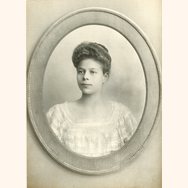Valentine Noémi (Valli) von Rothschild (1886-1968)
Valentine Noémi von Rothschild was born in Vienna on 25 May 1886, the sixth of seven children of the banker Albert Salomon Anselm von Rothschild (1844-1911) and his wife Bettina Caroline (1858-1892). Brought up with five brothers, she was aged only five when her mother died.
Marriage to Sigismund von Springer
Valentine was devoted to outdoor pursuits, especially gun sports, in which she was highly skilled. She was also an enthusiastic amateur photographer. She married the banker Baron Sigismund von Springer (1875-1928) on 8 September 1911, and named their two children Bettina (1912-1974) and Albert Adolf (1914-2008) after her parents. Although the Springers acquired British citizenship, they made their life in Vienna. From 1912 onwards they lived in the Palais Bourgoing at Metternichgasse 8 in Vienna's 3rd district, they also owned properties in Lower Austria and Styria, including Sitzenberg Castle near Tulln, acquired in 1913, with extensive hunting grounds. Their houses in the city and in the country were filled with antique furniture and artworks by Rudolf and Jakob von Alt, Matthias Schmutzer, Christian Brand, Laurenz Janscha and French and English painters, including Maria Louise Vigée-Lebrun, Thomas Lawrence, Joshua Reynolds and John Russell. Their extensive library of rare books in Sitzenberg included works on art, topography, history, and science, classical and romantic literature, letters, memoirs and armorial books.
Collections during the War
After the Anschluss, Valentine Springer was among those persecuted because of her Jewish origins. Deregistered for Paris at the beginning of 1939, she subsequently fled to Switzerland, where she was to remain after the end of the war. Valentine Springer's British citizenship made it difficult for the Nazi authorities to gain direct access to her assets, which were considered "enemy assets" from 1939 onwards and were placed under fiduciary administration in accordance with the "Verordnung über die Behandlung feindlichen Vermögens" (Decree on the Treatment of Enemy Assets) of 15 January 1940. Continued efforts to confiscate Valentine Springer's assets for the Reich after 1940 failed. In the case of both Metternichgasse and Schloss Sitzenberg, Valentine Springer formally remained the owner and was also recorded as such in the land register. However, the property in Sitzenberg as well as the furnishings of both properties were partially sold (allegedly to cover administrative costs). Robert Möder, art dealer and one of the heads of the so-called "Möbelaktion" (furniture campaign) of the Property Transaction Office, and architect Franz Wilfert prepared appraisal lists for this purpose, in which the furnishings of both houses were grossly undervalued. The antiquarian Werner Heck appraised Valentine Springer's engravings. Most of the interior furnishings in Metternichgasse were to be sold by April 1941. In November 1940, the Kunsthistorisches Museum (KHM) in Vienna took over eight paintings by English and French great artists into the restoration workshop and purchased them in February 1941 for 35,000 Reichsmark. From December 1940, Palais Metternichgasse was rented to the army base administration and two private parties. In August 1941, the architect and Dorotheum valuation master Ottokar Weigel submitted lists of appraisals that assessed the value of the interior furnishings at 347,000 Reichsmark. More valuable objects went to the Dorotheum for auction, the rest were to be sold freely or offered in advance to the Hitler Youth, which moved into Schloss Sitzenberg at the end of 1941. In November 1941, the Institute for Monument Preservation placed the archive and library holdings of the castle under monument protection and the Reichsstatthalterei Niederdonau (Reich Governor's Office Lower Danube Region) ordered their transfer to the Gauarchiv (Regional Archive), Herrengasse 11. The archive holdings stored in the Dorotheum were finally handed over to the Reichsgauarchiv (Reich Regional Archive) in October 1944 and recovered in the Parish House Ravelsbach at the end of 1944. In 1942 and 1943, there were further sales and auctions from Sitzenberg's holdings.
Life after the Second World War
In the post-war years, Valentine Springer was registered alternately in Vienna and Zürich. In 1946, the British military government entrusted Ferdinand Maier with the administration of Valentine Springer's assets. In the same year, Valentine Springer authorised lawyer Karl Trauttmansdorff to carry out the restitution negotiations. The latter filed criminal charges against Robert Möder, among other things. In fact, in the course of the investigation, art objects ("furniture, pictures, porcelain") from the palace in Metternichgasse were secured from Möder and returned to Valentine Springer. In November 1947, the Federal Ministry of Education approved a restitution settlement concerning the paintings in the KHM: The KHM committed itself to restituting seven of the eight paintings to Valentine Springer, in return and as a prerequisite for the granting of an export permit, Valentine Springer was to give the painting of Diana Sturt by Thomas Lawrence to the museum. In 1948, Valentine Springer exported the rest of her furnishings stored in Metternichgasse to Switzerland. In 1950, she sold Schloss Sitzenberg, which today houses a Higher Federal School for Food and Agriculture, to the Republic of Austria. A large part of the building in Metternichgasse was rented to the Republic of Austria for an indefinite period in 1950, among other things for a branch of the University of Music and Performing Arts Vienna and was finally purchased by the latter in 1983. In 1950 Valentine Springer donated 163 objects to the Volkskundemuseum. In the early 1950s, Valentine donated graphic works to the Albertina in Vienna, furniture to the Austrian Museum of Applied Arts, and oil paintings to the Museum of Military History.
Valentine died on 24 July 1969 at Lunz am See. In 2013, the Art Restitution Advisory Board recommended the restitution of the painting by Thomas Lawrence from the KHM to the legal successors of Valentine Springer; in 2014, the painting was returned.
Information on collections, courtesy of The Austrian Commission for Provenance Research.
